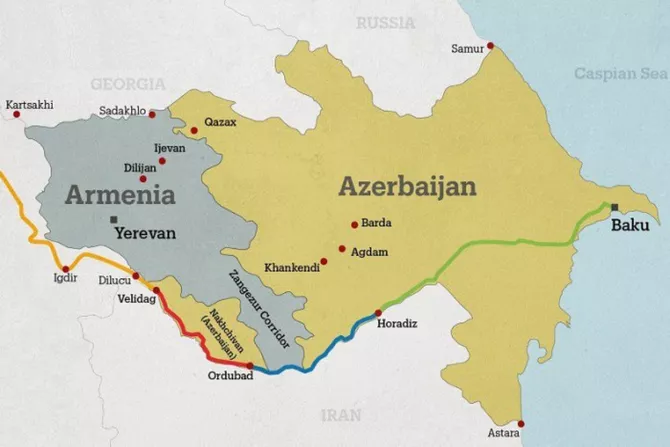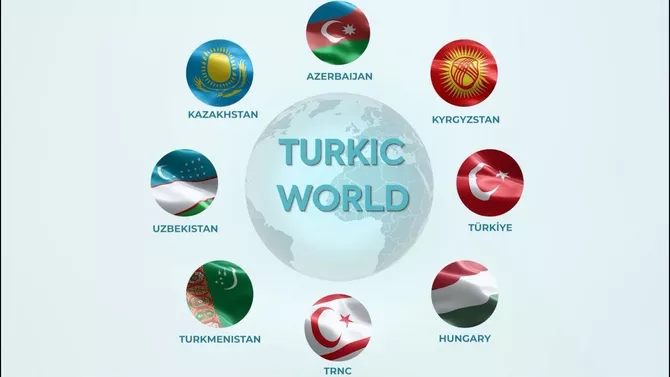
The Zangezur Corridor has quickly become a central element in the shifting landscape of the South Caucasus, intertwining regional infrastructure goals with the delicate and continuing reconciliation efforts between Azerbaijan and Armenia.
Beyond a simple transport link, the corridor embodies a broader strategic vision of connectivity, economic integration, and post-conflict normalization, underscoring its growing geopolitical and geoeconomic relevance, The Caspian Post reports, citing Modern Diplomacy.
The concept gained traction in the aftermath of the Second Karabakh War, particularly following the trilateral ceasefire agreement signed in November 2020. Clause 9 of that agreement references the unblocking of all economic and transport links in the region, which Azerbaijan interprets as a legal foundation for realizing the corridor. The proposed route would connect mainland Azerbaijan to its Nakhchivan exclave through Armenia’s Syunik province and extend to Türkiye, creating a seamless East-West trade artery that holds significant strategic weight.
More than just a logistical undertaking, the Zangezur Corridor has taken shape as a multifaceted political instrument. It has the potential to transform not only the physical landscape of the region but also the political narrative, from confrontation to cooperation. Its significance lies in its ability to promote post-conflict reconciliation, foster economic interdependence, and encourage a redefinition of national roles within a broader regional framework.

For Azerbaijan, the corridor serves as a strategic imperative. It offers a direct land connection to Nakhchivan, strengthens ties with Türkiye and the broader Turkic world, and consolidates post-war gains through infrastructure diplomacy. Baku views the corridor not just as a right under the 2020 agreement, but as a cornerstone of its broader ambition to become a pivotal transport and logistics hub bridging East and West, North and South.
At the same time, the corridor presents Armenia with a complex but potentially transformative opportunity. While it has sparked domestic political debate and security concerns, it also offers a chance to reposition Armenia as a regional connector. Rather than remaining isolated by closed borders with Azerbaijan and Türkiye, Yerevan could leverage the corridor to integrate into wider trade networks linking the Persian Gulf, Black Sea, and Eurasian corridors. This, in turn, could help diversify Armenia’s economy, attract foreign investment, and normalize relations with its neighbors.
These local and bilateral dimensions are unfolding against the backdrop of a rapidly changing global trade landscape. The corridor’s emerging relevance must be viewed within the broader context of shifting trade patterns and disrupted supply chains. A series of geopolitical shocks, including Russia’s full-scale invasion of Ukraine, persistent insecurity in the Red Sea and Suez Canal, and escalating sanctions regimes, has intensified the global search for alternative overland and maritime routes connecting Asia and Europe.
In this environment of reorientation, the Zangezur Corridor has gained visibility as a crucial missing link in the Middle Corridor, formally known as the Trans-Caspian International Transport Route (TITR). This strategic overland route connects China and Central Asia with Europe, bypassing Russian and Iranian territory. The Zangezur section, by linking Azerbaijan with Nakhchivan and Türkiye, would streamline connectivity across the Caspian Sea, South Caucasus, and Anatolia. It enhances the Middle Corridor’s viability by reducing border crossings, shortening transit times, and improving multimodal interoperability across rail, road, and maritime networks.

The corridor’s integration potential is further reinforced by its alignment with key international connectivity strategies. For the European Union, it complements the Global Gateway Initiative by supporting sustainable infrastructure free from geopolitical constraints. For China, it offers an additional Belt and Road Initiative (BRI) route that avoids maritime chokepoints and Western-dominated sea lanes. For Türkiye, the corridor advances its vision of becoming a continental logistics hub and deepens its leadership within the Turkic world. In essence, the Zangezur Corridor is evolving from a regional infrastructure plan into a critical component of Eurasia’s emerging transit architecture-one that can enhance global supply chain resilience in an increasingly fragmented world.
This broader geostrategic significance has been matched by renewed political momentum. The recent Abu Dhabi summit between President Ilham Aliyev and Prime Minister Nikol Pashinyan marked a turning point in dialogue. Held without traditional mediators, it signaled a pragmatic shift toward direct engagement and regional ownership of the peace process. By hosting the bilateral summit, the UAE introduced a fresh, non-aligned platform for conflict resolution, free from the entrenched geopolitical rivalries that have historically shaped the South Caucasus. While a final agreement remains pending, both sides demonstrated a willingness to engage in results-oriented discussions.
Against this backdrop, the Zangezur Corridor could serve as both a confidence-building mechanism and a shared economic interest. Its development promises tangible benefits, such as infrastructure modernization, transit revenues, and greater regional integration, that could help reduce longstanding tensions. However, progress hinges on addressing several critical issues, including legal guarantees, sovereignty concerns, border control arrangements, and the involvement of third parties in ensuring security and compliance.

The corridor’s success also depends on the broader alignment of regional and international stakeholders. Türkiye has been a vocal proponent, viewing the corridor as a linchpin of Turkic integration under the Organization of Turkic States (OTS). Russia, once central to post-war mediation, has seen its influence diminish due to its preoccupation with Ukraine. The European Union has stepped up its diplomatic engagement, seeing connectivity as a tool for economic stabilization and strategic diversification. Meanwhile, China remains a pragmatic observer with strong commercial interests and a growing stake in uninterrupted transcontinental transit flows.
The Zangezur Corridor is no longer just a theoretical infrastructure project; it has evolved into a strategic axis at the crossroads of regional reconciliation and global realignment. It embodies a layered significance, serving both as a tangible outcome of post-conflict diplomacy and as a linchpin in emerging trans-Eurasian trade and transit architecture. Its dual function as a symbol of normalization and a driver of geoeconomic integration underscores its far-reaching impact on the South Caucasus and beyond. Moreover, the Zangezur Corridor’s strategic resonance extends beyond bilateral concerns. It forms part of a broader realignment of supply chains and transport corridors in response to shifting geopolitical pressures-from the disruption of northern routes through Russia to vulnerabilities in maritime chokepoints like the Suez Canal. In this changing landscape, the South Caucasus is poised to become not just a transit zone, but a geopolitical fulcrum where infrastructure and diplomacy intersect.
Share on social media